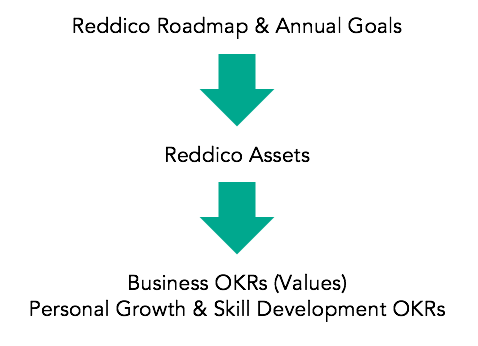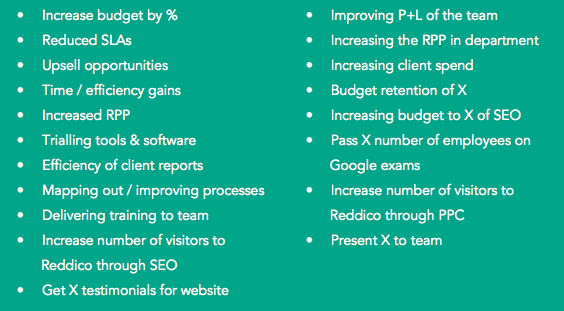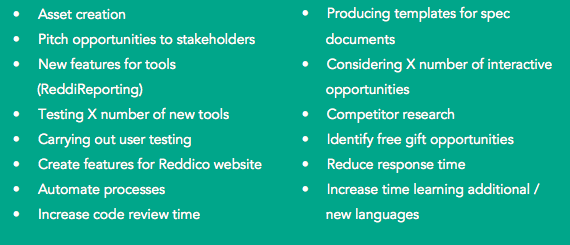
Our culture revolution. Part 7: The final piece of the OKR puzzle
We’re just a normal agency. You may own one. You may work for one. We’re ticking along nicely, picking up new business and growing at a good pace. The team size has upped from 1 to 20 in five years, with plans of reaching 50 by 2021. Everyone seems happy. But we want more.
Day Zero was the launch of our manifesto. Its aim? To revolutionise our culture, attract amazing talent, and be recognised nationally as a great place to work.
Over the course of the next few months we’ll be taking you to the heart of Reddico, sharing our highs, our lows, and our eureka moments. We’ll be honest and open about everything. What works. What doesn’t. Whether you’re here for inspiration, to watch us fail, or out of sheer curiosity, welcome along.
No hours. No managers. Rules set by the team. Let’s see what happens next.
Previously...
Last time we started to look at Daniel Priestley’s 24 assets – the assets he says every business needs to future-proof, sustain and grow. We connected these assets to our new objective plans, OKRs.
In summary, OKRs have been adopted by many of the world’s most successful businesses and can be used in all areas of a company. For each objective, there are a series of key results (the metrics you’ll use to help you reach the overall target).
Taking the 24 assets and incorporating our newly defined values, we started to flesh out a unique structure, which the team could use going forward to set their own OKRs.
We settled on three objectives each quarter:
Two business OKRs
One personal growth OKR
It was all coming together, but a couple of questions remained. c
Let’s find out.
Adding our top level goals to the mix
If you’ve followed this journey from the start, you’ll already know our top level goals. We introduced them in the first post, essentially defining what success would look like if our culture revolution was successful.
We defined our 2018 targets as:
Revenue target: £1.85m
External (client) NPS score: 75
Internal (team) NPS score: 75
For a quick reminder of NPS and how it works, take a look at this handy explanation.
[embed]https://www.youtube.com/watch?v=qWKipJefrN8[/embed]
So, there are three top line targets for us as a business. We want to sustain the accelerated growth we’ve enjoyed over the last five years, ensure clients are delighted with our service, and make sure the team love coming in every day.
How will we achieve this?
By establishing and improving our assets, and by empowering the team to have an impact on all areas of the business. That’s what OKRs would be doing.
This gives us three tiers. Our top line goals, our assets, and our OKRs. They’ll all feed into one another and drive the business forward.

Can every department set OKRs?
Before bringing this to the team and asking for their feedback, we first needed to make sure OKRs are foolproof. It’s all well and good rolling this out, but if it becomes incredibly difficult for areas of the company to define their objectives, it’ll fall flat on its face.
And there was only one way to find out.
We spent brainstorming sessions understanding every area of the business and defining potential objectives the team could use.
Our departments include:
SEO
PPC
Content marketing
Operations
Sales
Finance
Development
Administrative
A real mixed bag. We’ve included the PowerPoint presentation we shared to the team, which offers a range of examples of how departments could engage with OKRs. However, here’s an insight into SEO and PPC.

Taking this, an example OKR could be:
Business OKR: Make a better impact on the clients I work with
1. Have a client retention rate of 100% over the next quarter
2. Encourage 3 clients to take on an additional service with Reddico
3. Get 5 client reviews on Google
Personal Growth & Skill Development: Improve my understanding in technical SEO
1. Review 10 videos on technical SEO and provide best practice tips to the team
2. Attend 1 course on technical SEO to help better my skills
Here are some ideas for how the development team could start to define their OKRs:

These may lead to OKRs such as:
Business OKR: Improve the products we offer to clients as part of the Reddico experience
1. Pitch 4 ideas to key figures on products we could develop and launch
2. Produce a free asset we can provide as a ‘no strings attached’ gift
3. Identify 5 things our competitors are doing, that we could do better
Personal Growth & Skill Development: Improve the way I pitch ideas to key stakeholders
1. Produce 3 templates for presenting a spec document
2. Attend a course on creating spec documents for clients and internal use
For more department examples, please see the accompanying presentation.
Rolling out to the team
With everything in place, it was time to introduce this new concept to the team. The shared PowerPoint is what we presented, highlighting everything we’ve spoken about in this three part section.
The idea was for everyone to talk about OKRs within their team and measure against one another for whether they’re ambitious and tough enough. As with any new system, the team would need time to review and understand the reason these were being implemented. That’s why there was a good month or so between the initial announcement and the first set of OKRs being finalised.
Of course, we welcomed honest feedback from the team, but the reaction was largely positive to begin with – no red flags or concerns were raised.
You can view the slideshare here:
Reddico's OKRs Presentation – Goals, Objectives and structure from Luke Kyte
What’s next?
Next week we’re moving away from OKRs and to another part of the Job Ownership section of our manifesto. Whilst we’ll be revisiting OKRs in the future to discuss how successful they’ve been, it’s time to go client-side.
The NPS score is something we’ve been using for the last 18 months or so to various success. We want to discuss this, and our plans for making it a prominent part of our work.
Some of the ambitious areas of our manifesto can’t be rolled out until we know we’re servicing our clients to a high standard and ensuring they’re put at the forefront of everything we do.
Sign-up to Reddico News
To keep up-to-date with the latest developments in the world of SEO, our insights, industry case studies and company news, sign-up here.




